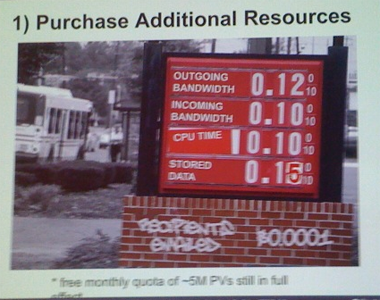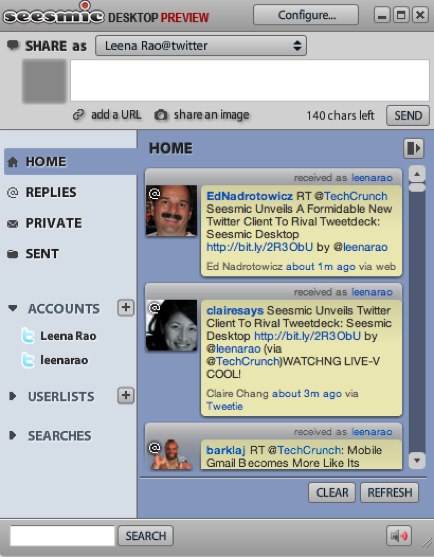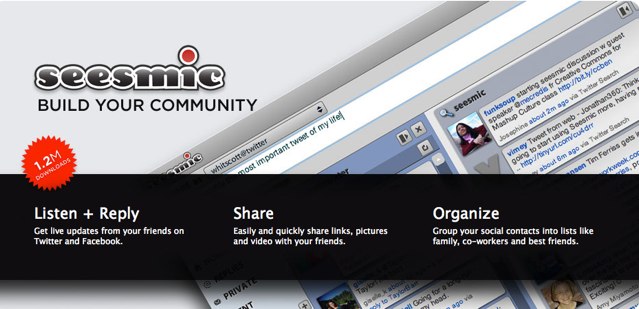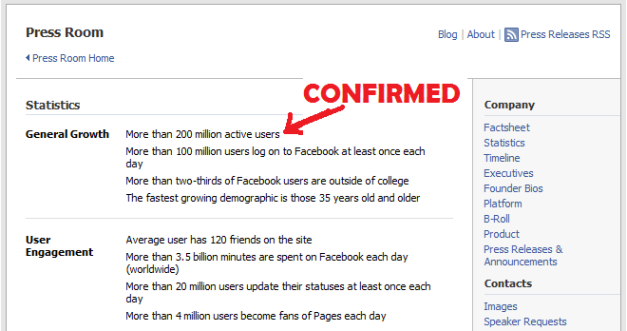The Latest from TechCrunch |  |
| Hot Rods: Top Car Social Networks CarDomain And StreetFire Merge Posted: 08 Apr 2009 08:45 AM PDT
CarDomain was funded entirely by Algard. StreetFire has taken two rounds of financing totalling nearly $8 million from Lightspeed Venture Partners. Jeremy Liew, the Lightspeed partner who led those investments, will take a board seat at the combined entity. The companies cater to car enthusiasts which are for the most part men between 16-30. Comscore shows relatively flat growth over the last year for both sites - 3.2 million monthly uniques worldwide for CarDomain, and 1.1 million for StreetFire. The companies say their internal Google Analytics show about 5 million uniques combined for the company, after removing estimated duplicate audience. WidgetFire also has a video widget that reaches another 4 million or so unique visitors a month via sites that have embedded it. Both companies have gone through layoffs in the last year. CarDomain has trimmed staff to a dozen from fifty employees a year ago. StreetFire has also let about 8 staff go, and is also currently at a dozen employees. The companies say no further layoffs are needed and expects to hit profitability this summer. Crunch Network: CrunchGear drool over the sexiest new gadgets and hardware. |
| TweetDeck Counters Seesmic Desktop Release With Major New Features Posted: 08 Apr 2009 08:14 AM PDT
The Twitter desktop client wars are on. Yesterday, Loïc Le Meur announced a TweetDeck rival dubbed Seesmic Desktop that not only looks a lot like the popular AIR application (more popular than any other desktop client according to statistics) but also heavily competes with it on a feature level. TweetDeck founder Iain Dodsworth, not to be outdone by the announcements, sent an e-mail out to his contacts just now about an upgraded version of the software which should be available for download real soon. According to the e-mail, this is an unscheduled update, but it tackles one of the major issues users have been struggling with and complaining about: memory leakage. In the message, Dodsworth says he has been working closely with Adobe for a fix, but stresses that this doesn’t completely solve the problem of the app being quite the memory drain (he says this is still being worked on), only that memory usage will be capped so you can keep it turned on “day and night’” (do you?). The new version of TweetDeck (v0.25) will also include a number of bug fixes and new features, including a Digg URL shortener, support for Spotify URLs (so you can play a song from a tweeted link directly in the Spotify player), previewing of TwitPic images inside the desktop app and preview of information about short URLs within the application before opening the link. The biggest new feature being rolled out to everyone today is Facebook integration, so you'll be able to view your Facebook friends' status updates in a new column alongside your TWitter updates. You can also see when your Facebook friends are online and start a chat with them from within TweetDeck, simply by clicking their name. However, you cannot comment on their status message from within the client. This is of course making TweetDeck more a lifestreaming service than a Twitter client, so it might have to change its name if it keeps on adding integrations with other services. Finally, you can now record and share short videos directly from TweetDeck thanks to an integration with 12seconds (a Seesmic competitor). Both the Facebook and the 12seconds integration were already included in test releases, but as of today they’ll be included in the full beta version of the app. Crunch Network: CrunchBoard because it’s time for you to find a new Job2.0 |
| Does Israel Still Have its Mojo? AOL Certainly Thinks So Posted: 08 Apr 2009 07:44 AM PDT
Nissenbaum, considered by Israel’s startup community as “one of the good guys” is known for two startup successes:product lifecycle management company SmarTeam which was acquired by Dassault Systemes back in 1999, and most recently, Q&A site Yedda which was acquired by AOL in 2007. In his new role as Country Manager Nissenbaum will focus on establishing tighter connections with the local hi-tech scene by promoting AOL’s developer network and the services that power such known brands as AIM, ICQ, Bebo, Winamp and Mapquest. His attention will also be placed on identifying local technologies and products of value to AOL for M&A consideration—AOL currently has over 200 employees in Israel across several companies it has acquired over the years, namely: ICQ, Relegance, Quigo and Yedda. Crunch Network: CrunchBoard because it’s time for you to find a new Job2.0 |
| Zuckerberg Admits Facebook Now Has 200 Million Users Posted: 08 Apr 2009 06:41 AM PDT
Zuckerberg goes on with the usual talk about how the service does its part to help change the world by making information sharing easier etc., but it gets interesting again when he embeds a video of a heat map that shows Facebook’s growth since 2004, depicting how quickly people across the world are connecting on the network. Unfortunately, it can only be viewed and shared on Facebook, but here’s a direct link to the video. Update: there you go (it’s like magic): Mark Zuckerberg also points to a new profile page for Facebook for Good, an effort to group all the stories from Facebook users “about how Facebook has helped them give back to their communities, effect change or connect with a distant relative.” Facebook’s growth keeps on amazing. In January this year, the official number of users was still 150 million, and grew to 175 million in February. That means that a stunning 50 million people signed up for the social network in 2009 alone to date (or 500,000 per day, more than the entire population of Luxembourg). At the end of last month, we reported that its traffic is going through the roof too, particularly in the U.S., according to recent worldwide Comscore data. Comscore said more than 1 in 4 people with Internet access visited Facebook in February 2009, translated to 276 million monthly unique visitors (or more than twice the size of MySpace’s traffic).
As usual, Compete’s traffic data paint a picture of lower visitor numbers for both companies but reports a similar trend.
Crunch Network: MobileCrunch Mobile Gadgets and Applications, Delivered Daily. |
| Micro-Blogging Meets Micro-Payments, Courtesy Of Tipjoy’s API Posted: 08 Apr 2009 06:03 AM PDT
Inserting payments made through Tipjoy into your Twitter stream can be an invaluable way to spread the message about what it is you’re buying or donating to, much like sharing your activities, digital media you like and applications you use can spread virally through social networking sites like Facebook. With the Twitter Payments API, developers now have an easy way to integrate payment handling into third-party Twitter applications and potentially benefit from the network effect for all the people who use their service. Making a payment involves posting a tweet under these formatting rules, e.g. ‘p $2 @robinwauters’ (thanks!). After posting, Tipjoy will record the transaction by using the Twitter search & REST APIs. Note that this is an asynchronous process, not immediate, although real-time transactions are also possible. For more information about how it works along with some examples, go here. For now, this only works directly through Tipjoy accounts and PayPal, although the company is working on additional support for credit cards and checking accounts. Also worth noting is that transactions are currently only available in USD although other currencies are said to be on the way. In any case, it’s a far more robust solution for micro-payments through Twitter than its competitor Tipit, which merely uses Twitter as a sort of relay between PayPayl account holders and the person or company on the receiving end. The company, which was originally seed-funded by Y Combinator and went on to raise $1 million in Series A financing in September 2008, is currently running a contest for developers who use the API for their application, and is giving away some free schwag and one Macbook Air for the winner. Check it out here. The startup will be posting ideas for applications on this blog and their own Twitter account, but we’d be happy to learn what you can come up with, too. Crunch Network: CrunchBase the free database of technology companies, people, and investors |
| Dictionary.com Launches Free iPhone App Posted: 08 Apr 2009 04:55 AM PDT
Dictionary.com, part of the Ask.com network, has launched a free iPhone app that delivers lets you look up definitions and synonyms from Dictionary.com and Thesaurus.com, reaching into a database of more than 275,000 definitions and 80,000 synonyms. The app also features audio pronunciations, similarly spelled words and Word of the Day. The app lets you easily access spelled words, alphabetical indexing, synonyms example sentences, non-standard uses, word origin and history. Another cool feature of the app is the ability to access definitions and synonyms offline. You can also hear pronunciations of words. The app store currently features ten dictionary apps with the Merriam-Webster Dictionary’s app priced at $24.99. Dictionary.com’s app. Dictionary.com was bought by IAC-run Ask.com in July of 2008 when the conglomerate bought Lexico, the operator of Dictionary.com, Thesaurus.com and Reference.com. Dictionary.com drew nearly 11.2 million unique visits in March, according to Compete. Merriam-Webster.comhad over 7 million unique visits in March.  Crunch Network: CrunchGear drool over the sexiest new gadgets and hardware. |
| Open Text Buys 3D Interface Innovator Vizible Posted: 08 Apr 2009 04:27 AM PDT
Vizible essentially transforms consuming just about any type of content into a rich, visual 3D experience and thus aims to ‘humanize’ how people interact with digital media. The company breaks the Web into basic units which it refers to as “cells”, which can be virtually any type of media: text, images, audio, video. Once the media has been placed in a cell, that cell can then be tagged, categorized and manipulated in a number of ways. The units can be filtered, searched and organized; they can also be coded to respond to input, linked to other content, or viewed in a three-dimensional space along with other cells. The technology was used by AT&T (an investor in Vizible) for its 3D browser initiative Pogo, which we covered when we learned the company’s business development unit was working it, although the project never actually came to fruition; the website PogoBrowser.com now redirects to AT&T Music. Open Text, a publicly-traded company, will fold Vizible’s products into its own digital media solutions, which help its customers manage rich-media content. All Vizible employees will become part of the company’s Digital Media group and remain in the Toronto area, where Open Text also has an office. Crunch Network: CrunchBoard because it’s time for you to find a new Job2.0 |
| Posted: 08 Apr 2009 02:06 AM PDT  Obviously it's really hard to convince people to drive tanks in a German office remotely over the Internet for a few Eruro so the folks at RCTiger have now made their service free. The service, as you'll recall, is basically a fun game that lets multiple players compete in real-time using model tanks in a cute little wooded playing field. They've made the game run 24/7 now and are basically giving away spots for free, presumably to amuse and enthuse audiences who might be put off by paying for such a service. Obviously it's really hard to convince people to drive tanks in a German office remotely over the Internet for a few Eruro so the folks at RCTiger have now made their service free. The service, as you'll recall, is basically a fun game that lets multiple players compete in real-time using model tanks in a cute little wooded playing field. They've made the game run 24/7 now and are basically giving away spots for free, presumably to amuse and enthuse audiences who might be put off by paying for such a service. |
| Sosius launches a zoomable fractal map for data aches and pains Posted: 08 Apr 2009 12:01 AM PDT
Crunch Network: CrunchGear drool over the sexiest new gadgets and hardware. |
| Mobile Socializing: Limbo Merges With Brightkite And Announces $9 Million Funding Round Posted: 07 Apr 2009 09:49 PM PDT In the nascent world of mobile social networking, there are the big dogs (Facebook and MySpace) and everyone who wants to be a big dog. Two of the puppies just got bigger. Limbo is buying Brightkite, which all the tech kids are raving about, in a nearly all-stock transaction. It will change its name to Brightkite in a re-branding move, and gain Brightkite’s engineering team and product smarts. Limbo CEO Jonathon Linner will remain as CEO, while Brightkite founders Martin May and Brady Becker will take over product management and design. Meanwhile, Limbo brings a lot of cash to the table, having just raised a previously undisclosed $9 million round of financing in January, 2009. Nexit Ventrures was the lead, and existing investors Azure Capital, Draper Fisher Jurvetson, and New Enterprise Associates also participated. Brightkite, meanwhile, started out as a TechStars startup and was funded with just $1 million in angel money. This marks the third exit from TechStars’s Class of 2007—the other two being SocialThing to AOL and IntenseDebate to Automattic. The combined company will employ 35 people and boast two million active users. That should keep it in the running with other growing mobile social networks such as Loopt, which has more than one million active users, and Mig33, which may have 10 million or more. The enlarged engineering team should help Limbo/Brightkite push out new features at a faster pace and keep up with the front pack. Both Limbo and Brightkite have iPhone apps, and both use Facebook Connect to plug into people’s existing social network. Here is how we described the Brightkite app when it first came out:
Meanwhile, Limbo is more centered around the activities of the people around you and connecting with them that way. We included Limbo in this roundup, where we concluded it could do a better job with locating the exact position of friends on a map. Brightkite’s Fire Eagle implementation should help with that. Something tells me this is just the beginning of the consolidation in mobile social networking. Crunch Network: CrunchBoard because it’s time for you to find a new Job2.0 |
| Live From Google Campfire ‘09: Java Support Launches Posted: 07 Apr 2009 07:00 PM PDT For the rest of the videos, visit the archive here. We’re here at the Google campfire event, where Google is celebrating the first birthday of App Engine and is planning planning to unveil new developer-related features. The event is being held in Google’s Building 43 instead of an outdoor amphitheater because of rain, but Google has decked out the room with a virtual fireplace, log podium, and atmospheric lighting. At this point Google hasn’t publicly announced what they’re launching tonight. We’ve heard that Java might be coming soon, but that could also be coming at Google’s I/O conference next month. We’ll begin live blogging as soon as the event begins. For now, we’re live streaming video from inside the virtual campfire. Update:Here is the link for the Java Signup For App Engine - First 10,000 developers to sign up get access. 7:37 PM PST: The event is starting
     Crunch Network: CrunchGear drool over the sexiest new gadgets and hardware. |
| Seesmic Unveils A Formidable New Twitter Client To Rival Tweetdeck: Seesmic Desktop Posted: 07 Apr 2009 06:23 PM PDT  I’m live blogging from video conversation platform Seesmic’s headquarters, where Seesmic’s founder Loic Le Meur, is previewing a new Twitter client. We reported earlier about the unveiling of the site. Le Meur says that this is still a work in progress and ongoing changes will made to the product. Seesmic, who also owns popular Twitter app Twhirl, has launched a new Twitter client, Seesmic Desktop. Like Twhirl, Seesmic Desktop is a desktop app, operated by Adobe Air. Seesmic Desktop allows you to view multiple accounts in one window, unlike Twhirl, where you have to view multiple accounts in different windows. It looks like it was designed to rival competitor TweetDeck, which is the most popular desktop client for Twitter. Le Meur says that Seesmic will discontinue adding features to Twhirl (he jokes that it has a difficult name) and will primarily focus on building out Seesmic Desktop. Here are a few of the nifty features Seesmic Desktop will have: Multiple Accounts Lists Photos and Video Support for Social Networks Stability Shorten Urls Search This new client is like an upgraded, stronger Twhirl with even more powerful capabilities. According to LeMeur, Twhirl has been downloaded 1.2 million times and is the leading Twitter client on the web. Twitstat says that Twhirl is the 4th most popular Twitter client, behind rival Tweetdeck, which ranks as #2 on the list. But this new app could overtake Tweetdeck with its new functionality. Its actually similar in some ways to AlertThingy. Le Meur wants this client to be the Bloomberg of social software, aggregating all content into one (free) desktop app, perhaps becoming the desktop app version of FriendFeed along the way. Disclaimer: TechCrunch editor Michael Arrington is an investor in Seesmic, although I am not.   Crunch Network: CrunchBase the free database of technology companies, people, and investors |
| ShoeMoney Sues Google Employee For AdWords Violations Posted: 07 Apr 2009 05:57 PM PDT
The constant hunt for valuable Google AdWords keywords is akin to Search Engine Optimization - a dark magic that can become very lucrative for those that can figure out how to best their competitors. It’s also very competitive, with companies bidding on keywords as they vie to outdo their rivals. Google has policies in place to protect companies from having their trademarked names abused in ads (for example, I couldn’t create an ad for Apple that linked to TechCrunch), but it isn’t perfect. Today we’ve gotten word of an example of what can go wrong with AdWords’ filters don’t work, and a Google employee may be behind it. Jeremy Schoemaker has built a name for himself as an online marketing guru at Shoemoney.com, where he writes on a variety of topics, mostly related to making money on the web. Outside of the marketing community he is perhaps best known for this famous photograph, in which he shows off a check displaying his monthly earnings from Google AdSense that total over $130,000. Unsurprisingly, other marketers have tried to build off Schoemaker’s success through dubious means, registering ads through Google’s AdSense program that use the word ‘Shoemoney’ in their text - a term that Schoemaker has trademarked. Google forbids the practice, and Schoemaker has been able to fend off violations in the past without going to court. But the latest offense was different. Beginning 4 months ago, Schoemaker began to notice a new violator, who was sending an ad for “Shoemoney” to the domain myincentivewebsite.com. Repeated attempts to contact Google and the offending parties went unanswered (as did a Cease and Desist). The owners of the offending website had set their contact information to ‘private’ through their registrar, so contacting them directly wasn’t easy. Schoemaker got a court ordered subpoena that ordered the violator’s webhost to disclose his personal information.
With his real name in hand, Schoemaker finally managed to get in touch with the alleged violator. The defendant claimed to be unaware of any breaches of Google’s Terms of Service or the Shoemoney trademark. Schoemaker isn’t convinced, stating that “he played dumb every time and was very deceitful with his responses”. To make matters worse, the defendant attempted to clear his name by sending Schoemaker a screenshot of his account featuring a list of keywords he was targeting - a list that Schoemaker says was incredibly similar to his own. That’s when things started to get strange. A friend of Schoemaker’s discovered that the violator had a number of friends on Facebook who worked for Google’s AdWords. A cached version of his LinkedIn profile stated that he is an employee at Google working as an AdWords Account Strategist, though the title has since been removed. A call to Google’s New York office revealed that someone with his name is listed in the directory, all but confirming Schoemaker’s suspicions that he was dealing with a Google employee. Schoemaker has filed suit against the violator (and his father, who stepped forward to claim the offending website as his own). At this point it’s still unclear if the violator used his position at Google to bypass its trademarked words filters or to access Schoemaker’s own list of keywords, but at the very least it’s hard to believe the Google employee was unaware that his actions were in violation of Google’s Terms of Service. We have been unable to get in touch with the defendant. Google has given us the following statement: Crunch Network: CrunchGear drool over the sexiest new gadgets and hardware. |
| Twitter Client Arms Race Continues - Seesmic To Up The Ante Posted: 07 Apr 2009 05:31 PM PDT
Seesmic will unveil a new version of it’s Twhirl Twitter client tonight at a press event starting around 6:30. Not many details on what they’re launching yet, other than the fact that they’ve rebuilt Twhirl, which has been downloaded 1.2 million times. Seesmic isn’t releasing details, but the site they’ve set up for the new product shows the screenshot above, with multiple columns like TweetDeck, the new kid on the block that has taken the hearts of the Twitter elite. TweetDeck is far and away the most popular desktop client for Twitter. More details when the event starts, which you can watch from home here. You can sign up for the new version here. Note that I am an investor in Seesmic. Crunch Network: CrunchGear drool over the sexiest new gadgets and hardware. |
| Who Has The Most Photos Of Them All? Hint: It Is Not Facebook Posted: 07 Apr 2009 04:25 PM PDT
Photo-sharing on the Web keeps getting more popular as people transfer more of their digital photos from their the black holes of their computer hard drives to social networks where their friends and family can actually see them. Although Facebook Photos has emerged as the largest photo-sharing service in terms of users and is one of the fastest-growing of any size, it is still not the largest by the sheer number of images that it stores. That honor, for the moment, goes to ImageShack, which currently hosts 20 billion images, I’ve confirmed with the company (for more background on ImageShack, read this post). Facebook holds 15 billion photos, according to a spokesperson there. But it should catch up by the end of the year. Facebook users are adding photos at a rate of 850 million photos a month, compared to 100 million photos a month by ImageShack users. Good thing Facebook just fixed its storage architecture to be able to handle the bigger load. After Facebook and ImageShack, the third largest image warehouse on the Web appears to be News Corp’s PhotoBucket, with 7.2 billion photos. And then Yahoo’s Flickr comes in at 3.4 billion, which also includes some videos. Interestingly, coming in right behind Flickr in the photo count is social network Multiply, with 3 billion images. Multiply’s photo=sharing options are one of its main strengths, which make sit attractive to its core demographic of families and moms (an area where Facebook is still struggling). Picasa is probably up there somewhere, but Google won’t get any more specific than “billions” of photos have been uploaded “and millions of photos are uploaded every day.” In fact, with the exception of Photobucket, none of these services publicly discloses its latest image count. I had to ask each company individually. Some companies like Shutterfly refuse to disclose their numbers, and they are a publicly traded company. I am still waiting to hear back from Kodak about KodakGallery..com, but the trend lines of these older photo storage services are not encouraging (see second chart at the bottom of the post). Below are the figures I was able to collect directly from each company: Image Warehouses On The Web (numbers are total images stored)
Facebook: 15 billion PhotoBucket: 7.2 billion Flickr 3.4 billion Multiply: 3 billion Picasa "billions" (?) While Google chose to be vague, Yahoo was completely transparent. It provided the following additional stats on Flickr:
Photos that are public: 50% Photos that are tagged: 30% Geo-tagged photos: 110 million Number of unique tags: 38 million Amount of traffic that comes from search engines: 75% And Multiply shared with me the fact that its 12.5 million registered users are uploading an impressive 75 million photos a month. That comes to six photos per day per registered user, which is actually more than Facebook. Since Multiply encourages high-resolution uploads, it is handling 2.5 terabytes per day in image uploads. A little under one percent of its users, or 10,000 of them pay $20 a year for premium services such as unlimited storage and photo album backups. The one percent of premium users accounts for between 5 and 7 percent of all uploads. If you look at comScore numbers, however, it is clear that Facebook is gaining the most usage overall, with 161 million unique visitors worldwide in February. Flickr is a distant but strong second with 76.5 million visitors. Photobucket is at 58.6 million uniques, Picasa is at 39.9 million, and ImageShack is at 33.2 million.
Crunch Network: CrunchBoard because it’s time for you to find a new Job2.0 |
| Twitter hands over personal details of @Skype registrant to Skype Posted: 07 Apr 2009 04:23 PM PDT
Crunch Network: CrunchBase the free database of technology companies, people, and investors |
| Student Protests Are Turning Into A Twitter Revolution In Moldova Posted: 07 Apr 2009 03:23 PM PDT
Students in Moldova are using Twitter as a tool to mobilize opposition against a communist victory in Moldovian elections. According to reports, close to 10,000 protesters gathered at Moldova’s parliament in Chisinau, Moldova’s capital and were able to eventually break through police lines to storm into the building. From looking at the tweets on the subject, it appears that the demonstration turned into a violent coup attempt. In the last 48 hours, students from Moldova have been tweeting, trying to rally others into demonstrating against the communists. If you look under the search terms “pman” (stands for Piata Marii Adunari Nationale, a square in Chisinau) or “Chisinau,” you can see the tweets about the demonstration coming in a rapid pace. There are also videos on YouTube of the protest. There have been reports that there is limited cellphone reception in the square (thought to have been turned off by authorities). So protesters are using Twitter to give live updates via GPRS networks on their mobile devices. Twitter has long-been been a popular platform for breaking news, but this adds a new twist to the powerful capabilities of the micro-blogging service. The protests no doubt would have happened anyway and it is not clear how may of the actual protesters in Moldova are on Twitter. But it seems to be helping both as a coordinating tool and as a way to disseminate information about the events that are unfolding to the rest of the world. Here are a few sample tweets:
Crunch Network: CrunchGear drool over the sexiest new gadgets and hardware. |
| Happy Birthday App Engine. It’s Been A Good Year. Posted: 07 Apr 2009 02:04 PM PDT
And it has been a good year. Despite the fact that App Engine only supports Python applications, 150,000 developers have flocked to the service, says Google. They’ve launched 50,000 applications, and those apps generate more than 100 million daily pageviews. Look for Java, a much more popular programming language, to come soon. Possibly even this evening. Google says they eat their own dogfood, too, and have launched nearly 50 projects and small products on App Engine, including Google Moderator and Labs for Google Apps. Even President Obama has used (well, indirectly) App Engine, using Moderator to gather questions for a virtual town hall meeting on whitehouse.gov. Google says that the site peaked at 700 hits per second, and 92,934 people submitted 104,073 questions and cast 3,605,984 votes. In total, whitehouse.gov got approximately 1 million visits during the 48 hour open voting period. Crunch Network: MobileCrunch Mobile Gadgets and Applications, Delivered Daily. |
| PopSugar Launches March Madness For Celebrities: PopSugar100 Posted: 07 Apr 2009 01:32 PM PDT  Sugar Inc.’s flagship celebrity news and photo blog, PopSugar chose 128 celebrities and divided them into four groups and then ranked them from 1 to 32. The potential PopSugar 100ers are then paired up in head to head matches, at which point users can vote on who had the bigger year. Whoever wins will then proceed to the next round and so on through the rounds of Sweet 16, Elite 8, Final 4 right down to the single winner. The first round (you can vote on 64 celebrity matchups) starts today and lasts two weeks. After round one winners are determined, each round will last one week until a winner is declared in June. Readers who vote are entered to win a $3000 Chanel bag with every round they participate in. The winner of the bag also will be announced in June around when the new PopSugar 100 list is revealed. PopSugar co-hosted our TechCrunch Geek Goes Chic party in Los Angeles last year and is part of Sugar Inc., the incredibly popular blog platform for news about fashion, celebrities, entertainment, food and more. Read our review of the rapidly growing PopSugar here.  Crunch Network: CrunchGear drool over the sexiest new gadgets and hardware. |
| WatchMojo.com’s Videos Watched More Than 50 Million Times Posted: 07 Apr 2009 01:09 PM PDT
WatchMojo.com, a startup that produces professional videos and then syndicates them to social networking and media sites, has streamed more than 50 million videos since its launch in 2006. WatchMojo.com’s content is distributed to Hulu, MySpace, TV.com, Yahoo!, and YouTube as well as newspaper sites. (The Montreal-based startup also produces the business tech blog HipMojo). WatchMojo’s entertainment videos range from informational content (think About.com or Wikipedia) to parodies to evergreen faux newscasts (we’ve embedded two at the bottom of this post). The site has published close to 5,000 videos on a variety of topics including business, fashion, food, green living, health, technology and politics. Largely in English, its library includes multi-lingual and closed captioned videos as well. The company says streams of WatchMojo’s videos are steadily growing. They doubled from 13 million in 2007 to 28 million in 2008. Currently the site is averaging 4 million streams per month, with about half of those coming from YouTube. At that rate, it should come close to doubling again this year. WatchMojo.com generates revenue through licensing deals and stock video sales. It also creates branded content and package video advertisements for companies to distribute online. WatchMojo’s 50 million cumulative video streams is quite respectable for a niche Web video producer focusing on professionally-produced clips. But to put this in perspective, YouTube streamed an estimated 5.3 billion videos in February alone. And Hulu had 332.5 million professionally-produced video streams in February. A better comparison might be Next New Networks, another smaller online video content syndicator, which has had close to 400 million views of its videos, according to the company. That number is spread across 16 micro-video networks, which include Barely Political (home of Obama Girl), ThreadBanger (DIY fashion), and TMI Weekly (Life, tech and style). Here’s a popular video from WatchMojo showing some freestyle motocross jumps that has been watched on YouTube 1.4 million times: This one is on UNC’s basketball team: And here’s one on Wolverine. Apparently, they felt it was so realistic that they decided to run a disclaimer noting that Wolverine does not actually exist, but is only a comic book caharcter. (I kinda got that from the comic book illustrations, but thanks for the warning):
Crunch Network: MobileCrunch Mobile Gadgets and Applications, Delivered Daily. |
| Dynamic Widget Management System Goldenrod Extends Life Cycle Of Your Widgets Posted: 07 Apr 2009 01:08 PM PDT
But widgets also have one major flaw: They tend to get old fast and eventually fall off people’s pages (who, for example, wants to see dancing Christmas elves in April?). Here is where a new “content-managed widget system”, dubbed Goldenrod, comes in. Developed by Centric, an LA-based interactive agency, Goldenrod is looking to make widget marketing long-term and strategic - by giving brands dynamic control over their widgets (and apps). The key idea is to overcome the need to redesign, re-seed and re-propagate a widget or app every time a company decides to use social media for a marketing initiative. Goldenrod users can access an online control panel to alter the look and content of their widgets or apps that are already out there. Jason Stoddard, Managing Partner at Centric, says companies can change anything from text, video, photos and audio to skins - without having to program anything. So once the widgets are distributed on starting pages and social networks, Goldenrod can help extend their life cycles significantly, provided companies are able to come up with a good online marketing strategy for their products. Think of a chocolate maker that can run different widget campaigns during Easter and Valentine’s Day, but on the same installed base. Or a movie studio that can change already distributed apps every time a new film comes out without having end users do anything. That way, widgets can become a lot sexier (if done right) for users. And for companies, changing them comes pretty close to changing conventional websites. Goldenrod is already available and integrates with branded widget distribution service Clearspring. The first company to use the new system is Cotton, Inc. (their “Fab Finds” widget, used to promote fashion items made of cotton, is already live at MySpace). This widget makes use of Goldenrod’s integrated contesting function, which lets people get entries for sharing the widget, and automatically chooses a random winner (the giveaway deployed in this case is a so-called “Fab Find”).
Crunch Network: MobileCrunch Mobile Gadgets and Applications, Delivered Daily. |
| Efficient Vehicle Startups Vie For $10m Automotive X-Prize Posted: 07 Apr 2009 12:10 PM PDT
The entrants, hailing from 11 countries (but 80% American), range from upstart EV maker Tesla to University teams to a Neil Young-backed outfit running a ‘59 Lincoln with hybrid-electric guts. The rules, roughly, are:
Interestingly, none of the big automakers are getting involved — directly, at least. GM commented, saying they’re all working too hard on the Volt to dive into the X-Prize. Really? Too busy to write a check sponsoring a promising team that could use a couple grand? To be fair, the big guys likely already have their fingers in a few of these pies. And stuff like this. I already have a two-wheeled urban transport vehicle, but thanks. One might ask why so little money is going towards creating the innovations that may last a century, and so much to automakers which have failed to innovate for decades, but I think we all know the answer to that question. It’s “quiet you, unless you want a horse’s head in your bed.” The big news will mostly hit tomorrow, with X-Prize representatives answering questions and publishing lists, that sort of thing. We’ll keep you updated. [image credit: X-Prize Foundation] Crunch Network: MobileCrunch Mobile Gadgets and Applications, Delivered Daily. |
| Mobile Gmail Becomes More Like Its Desktop Father Posted: 07 Apr 2009 11:41 AM PDT  Google has launched a new Gmail mobile web app for the iPhone and Android-powered devices. The app has been revamped to have the same look and feel as your desktop Gmail. The app also has a new floaty bar (more on that below) and offers basic offline support. Google says that the app is faster in performing actions like opening an email, navigating, or searching, and let’s you access your Gmail messages even if your network connection is flaky. All of these new features are enabled through leveraging Google’s browser technologies, especially HTML5 and Google Gears. Google has recently demoed the app at industry conferences, but Google engineer Joanne McKinley writes on the Google Mobile blog:
The new Gmail for mobile also lets you easily archive, delete or move emails via a “floaty bar” that appears near the top of a screen whenever you select a message. The floaty bar gives you the options to archive, delete and take other actions and stays with you as you scroll through your inbox. Messages are also easier to read and labels look more like the Gmail labels you see on your desktop site. Also, the search menu has been placed up into the top header. For more, see Greg Kumparak’s take on MobileCrunch. Here’s a video on the new Gmail app: Crunch Network: MobileCrunch Mobile Gadgets and Applications, Delivered Daily. |
| Yahoo Messenger Brings Free Text Messaging To The iPhone Posted: 07 Apr 2009 11:23 AM PDT
Yahoo Messenger now has an iPhone app (iTunes link). It lets you IM your friends, see their status, share photos, share links, choose emoticons, and see recent conversations. It also lets you send free text messages by choosing a contact’s mobile phone number if they are not online. Replies come back to the app, which could save you a dime each time. When you leave the app to answer a call or do something else on your iPhone, your status is changed to idle. You can also sign out of the app entirely. (This is a workaround to the inability to have multiple apps running at the same time in the background on the iPhone). You can check out the video below to see how Yahoo Messenger looks on the iPhone, or get more details on the Yahoo Messenger blog.
Crunch Network: CrunchBoard because it’s time for you to find a new Job2.0 |
| Twitter Gets A TV Commercial For Free As New Users Get Their First Taste Of Fail Whale Posted: 07 Apr 2009 10:41 AM PDT
Twitter has been regularly featured on a number of television shows for some time now (I’ve always found CNN’s anchors to be a bit too enamored of the service), but this looks like the first time it’s been featured prominently in a commercial. As Biz Stone writes in the Twitter blog Sprint has just released a new ad called “What’s Happening”, during which an announcer spouts off a number of totally made-up statistics describing how people are using the Sprint network. Nestled in the middle of the ad, the commercial’s speaker states “233,000 people just Twittered on Twitter. 26% of you viewing this have no idea what that means” as a few dozen 3D blue Twitter birds fly around. I think the 26% figure is on the low side (many people who hear about Twitter every day still have no idea what it really means, and some people who have actually used the service still don’t really get it). But those 3D birds sure look cool. Oh, and that phone shown at the end? That’s a Palm Pre. Unfortunately Twitter doesn’t seem to be coping too well with its growth at the moment. The service was well known for its shoddy performance during the first half of 2008, but it has become quite stable since then (coping admirably with such large events as the Election). But in the last two days it has been reverting to its old ways - yesterday users noticed as they lost avatars and messages, which brought the service down for about an hour. This morning more issues are popping up with delayed tweets and errors. This is one of the first times that Twitter has really faced extended issues since it really started approaching the mainstream. Crunch Network: CrunchBoard because it’s time for you to find a new Job2.0 |
| You are subscribed to email updates from TechCrunch To stop receiving these emails, you may unsubscribe now. | Email delivery powered by Google |
| Inbox too full? | |
| If you prefer to unsubscribe via postal mail, write to: TechCrunch, c/o Google, 20 W Kinzie, Chicago IL USA 60610 | |


 In a
In a 
 Facebook CEO
Facebook CEO 

 Social micro-payments enabler
Social micro-payments enabler 
 Later today, enterprise content management juggernaut
Later today, enterprise content management juggernaut  I don’t cover enterprise applications often, but today
I don’t cover enterprise applications often, but today 









 Of course, we know that
Of course, we know that 




 Many companies, especially those in the consumer brand and
Many companies, especially those in the consumer brand and 



No comments:
Post a Comment